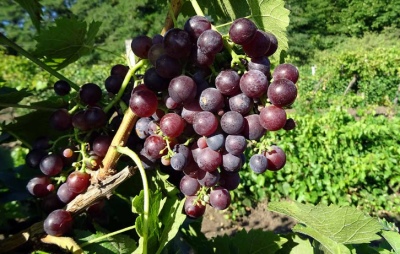
- Authors: VNIIViV them. Ya.I. Potapenko, authors: Ya.I. Potapenko, I.P. Potapenko, E.I. Zakharova
- Appointment: universal
- Berry color: dark purple
- Taste: pleasant, with nutmeg aroma
- With bones: Yes
- Ripening period: early
- Ripening period, days: 124
- Frost resistance, ° C: -25
- Bunch weight, g: 126
- Yield: 114 c / ha
Grapes are a favorite plant of many gardeners. Everyone seeks to plant an unpretentious species on their site, giving tasty berries and a large harvest. Early purple is a real treasure, which to this day occupies a leading position among winegrowers. The hybrid is valuable for the balanced composition of acids and sugars in fruits.
Breeding history
The hybrid was bred in 1947 by outstanding scientists from VNIIViV im. Ya.I. Potapenko. It is based on the genotype of the varieties Severny (Seyanec Malengra x Vitis amurenzis) and Muscat Hamburg.
Description
The bushes are of medium vigor. Young shoots ripen completely. The foliage is green with slight pubescence and dissection. The number of fruiting shoots is 80%. The number of bunches is 1.3-1.8.
Ripening period
Early maturation occurs 124 days after flowering. For the production of wine, they use the fruits harvested at the end of the month.
The number of fruitful shoots must be normalized, it is not recommended to overload the bushes. Overloading shifts the growing season and significantly reduces the yield.
Bunches
Small, medium density, conical in shape. The weight of one brush can reach 126 g.
Berries
Regularly rounded, sometimes slightly oval. Medium in size, 13-18 mm long and 12-16 mm wide. The color of ripe fruits is dark purple.
The pulp is white and juicy, with 2-3 seeds per berry. The skin is of medium density, with a bluish-gray waxy bloom, palpable when eaten.
Taste
On a ten-point tasting scale, they are rated at 7.7 points for a bright, rich, balanced taste of nutmeg and a pleasant aftertaste. The sugar level is 205-290 g / dm³, with low acidity - 4.8 g / dm³.
Has a universal purpose. It can be consumed both fresh and processed. It makes an excellent dessert wine with a light floral aroma, for example, "Steppe Rose Muscat". The sommelier in the tasting rate it at 8.5 points.
Yield
High-yielding. From one bush, you can collect up to 10 kg of the crop, and from a hectare - 114 centners. The vine is literally strewn with fruit clusters. The bunches lie well, tolerate transportation well.


Growing features
Not particularly whimsical to care for. But in order to receive a plentiful collection, it still needs to be looked after. The plant is undemanding to the composition of the soil. It can grow even on the poorest of soils.
The vineyard does not need to be created near trees and other structures that significantly shade the site.Lack of sunlight will prevent the berries from gaining the required amount of sugar.
Additional nutrition begins to be applied at the 3rd year of planting; before this, additional feeding is not necessary. Enough of those that were introduced during planting.
Watering should be abundant enough until the bunches begin to ripen. As soon as the berries begin to grow in size and change color, irrigation decreases. However, the weather conditions should be taken into account.
Landing
Before proceeding with planting, you need to carefully approach the choice of seedlings. Experienced growers are advised to purchase them in specialized stores or nurseries.
Pay special attention to the root system. The planting material should have 3-4 thick, moist, flexible roots, without signs of damage or disease. On the shoot itself, live buds should not fall off and peel off, in an amount of at least 3-5 pieces.
The best methods for propagating grapes are considered to be rooting cuttings or layering. These methods allow you to transfer maternal qualities to seedlings. More experienced gardeners also graft the plant.
Planting of Violet Early is carried out from May to October. It all depends on the climatic conditions of the region. Because of their vigorous growth, the seedlings are planted at a distance of at least 1.5 m. The hole is made up to 35 cm deep.

Pollination
The flowers are bisexual. There is no need to plant pollinator grapes nearby. The ovary is carried out almost completely, there is no pea.
Pruning
When pruning the vines, no more than 5-6 eyes are left, but subsequent adjustment of the shoots will also be required. Do not be afraid of strong pruning, the variety has high regenerative abilities.



Frost resistance and the need for shelter
The variety is frost-resistant, can withstand temperatures down to -25 degrees. To avoid icing the vine, it is advisable to cover it for the winter.

Diseases and pests
Despite the fact that the hybrid is quite staunchly resistant to many fungal diseases, especially mildew and gray rot, preventive treatment with special preparations should be carried out every year.
The culture is highly susceptible to powdery mildew, root and leaf phylloxera. Sulfur preparations mixed with fungicides are well suited to fight these infections.

If the grapes are exposed to any disease or insect, this is always reflected in its appearance.
Storage
Well-ripened bunches are harvested in dry weather when the dew has melted. Store in wooden or plastic boxes in one layer, in a cool place.











































































